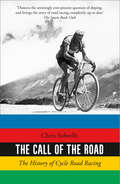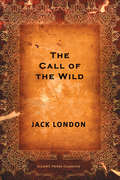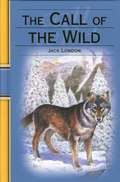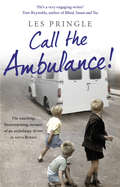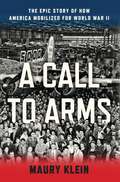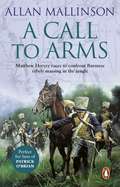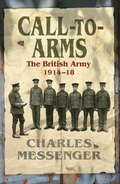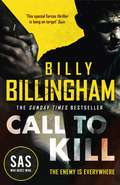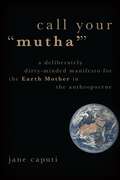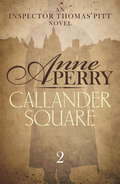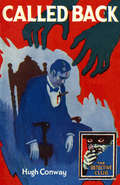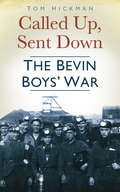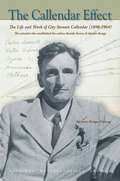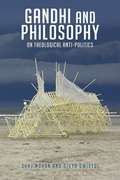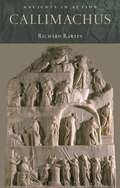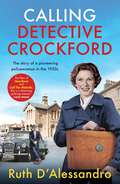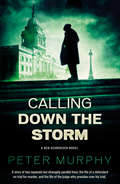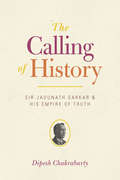- Table View
- List View
The Call of the Road: A Complete History Of Cycle Road Racing
by Chris SidwellsEddy Merckx. Fausto Coppi. Jacques Anquetil. Bernard Hinault. Beryl Burton. Marianne Vos.
The Call of the Wild
by Jack LondonBuck is a domesticated dog living with his loving family when he is stolen and sold off into the brutal life of an Alaskan sled dog, where must quickly learn how to survive in his new, wild life.
The Call of the Wild
by Jack LondonFirst published in 1903, The Call of the Wild is regarded as Jack London's masterpiece. Based on London's experiences as a gold prospector in the Canadian wilderness and his ideas about nature and the struggle for existence, The Call of the Wild is a tale about unbreakable spirit and the fight for survival in the frozen Alaskan Klondike.
Call Of The White Wolf (Mills And Boon Historical Ser.)
by Carol FinchA Gunshot Wound Sent John Wolf Straight To Paradise. Paradise Valley, that is, where an Irish hellcat with the face of an angel had rescued five orphans…and offered him a life that was more than just duty and danger. But would the truth of his past make their future together impossible?
Call the Ambulance!
by Les PringleExploding pressure cookers, a thwarted wife's deadly revenge and transvestites in distress - manning an ambulance in the seventies kept you on your toes.Having survived the rites of passage as a probationer, Les Pringle now has to face up to the reality of life as an ambulance man in Thatcher's Britain. He does this with humour and fortitude - two qualities which are essential if he is to cope with cases ranging from the absurd to the heart rending.From attending murder scenes to delivering babies ... it's quite a life for Les, and one that he and his shift mates tread with warmth and humour in equal measure.
A Call to Arms: Mobilizing America for World War II
by Maury KleinThe colossal scale of World War II required a mobilization effort greater than anything attempted in all of the world's history. The United States had to fight a war across two oceans and three continents--and to do so, it had to build and equip a military that was all but nonexistent before the war began. Never in the nation's history did it have to create, outfit, transport, and supply huge armies, navies, and air forces on so many distant and disparate fronts. The Axis powers might have fielded better-trained soldiers, better weapons, and better tanks and aircraft, but they could not match American productivity. The United States buried its enemies in aircraft, ships, tanks, and guns; in this sense, American industry and American workers, won World War II. The scale of the effort was titanic, and the result historic. Not only did it determine the outcome of the war, but it transformed the American economy and society. Maury Klein's A Call to Arms is the definitive narrative history of this epic struggle--told by one of America's greatest historians of business and economics--and renders the transformation of America with a depth and vividness never available before.
A Call To Arms: (Matthew Hervey 4) (Matthew Hervey #4)
by Allan MallinsonIndia 1819Matthew Hervey is charged with raising a new troop, and organising transport for India - for he, his men and their horses are to set sail with immediate effect.What Hervey and his greenhorn soldiers cannot know is that in India they will face a trial for which they are ill prepared. A large number of Burmese war-boats are assembled near Chittagong, and the only way to thwart their advance involves a hazardous march through the jungle.Soon Hervey and his troop are in the midst of hot and bloody action once again...'The book picks up a pace that mirrors a cavalry charge ...Hervey continues to grow in stature, while Mallinson himself continues to delight.' Observer
Call to Arms: The British Army 1914-18
by Charles MessengerThis is a comprehensive account of how the British Army coped with and adapted to the enormous challenges and pressures of the First World War -- the first major continental war that the army had had to fight for almost a hundred years. Following the course of the War, both on the Western Front and in other theatres, Charles Messenger tells how the British Army managed the challenges of command, training, technology and new weapons of war. He examines officer selection, medicine, discipline, the manpower crisis of 1918, the integration of women into the forces and many other topics.Based on years of original research, this will become the standard work of reference on the organization and administration of the biggest army Britain has ever put into the field.
Call to Kill: The first in a brand new high-octane SAS series
by Conor Woodman Billy BillinghamTHE FIRST IN A BRAND NEW SERIES FROM SAS: WHO DARES WINS STAR.A country in turmoil. A rescue mission gone wrong. A hero unlike any other fighting to save a broken world. Matt 'Mace' Mason is deployed on a deniable SAS mission in war-torn Yemen, becoming embroiled in a hostage rescue that goes terribly wrong. Pulling at the strings of the local political scene is not only the local warlord who is destined to become Mace's nemesis, General Ruak Shahlai, but hardbitten American arms dealer Erica Atkins, who controls a whole international network to her advantage.As well as his own team, Mace has to work, initially unwillingly, with female CIA Agent (and Islamic scholar) Redford. Together they will need to prevent an attack that would spark a regional war and create the largest environmental disaster the world has ever seen.DON'T MISS THE FIRST IN THE NEW MATT MASON SERIES FROM AN AUTHOR WHO HAS BEEN THERE AND DONE IT ALL, BILLY BILLINGHAM. About the AuthorBilly Billingham spent 17 years in the SAS. He was responsible for planning and executing strategic operations and training at the highest level in locations including Iraq, Afghanistan, South America and Africa, and has led countless hostage rescues. He later became a bodyguard to A list celebrities such as Brad Pitt, Sir Michael Caine, and Tom Cruise. Since 2015, Billy has been one of the lead presenters on the popular Channel Four series SAS: Who Dares Wins.
Call Your "Mutha'": A Deliberately Dirty-Minded Manifesto for the Earth Mother in the Anthropocene (Heretical Thought)
by Jane CaputiThe ecocide and domination of nature that is the Anthropocene does not represent the actions of all humans, but that of Man, the Western and masculine identified corporate, military, intellectual, and political class that long has masked itself as the civilized and the human. In this book, Jane Caputi looks at two major "myths" of the Earth, one ancient and one contemporary, and uses them to devise a manifesto for the survival of nature--which includes human beings--in our current ecological crisis. These are the myths of Mother Earth and the Anthropocene. The former personifies nature as a figure with the power to give life or death, and one who shares a communal destiny with all other living things. The latter myth sees humans as exceptional for exerting an implicitly sexual domination of Mother Earth through technological achievement, from the plow to synthetic biology and artificial intelligence. Much that we take for granted as inferior or taboo is based in a splitting apart of inherent unities: culture-nature; up-down, male-female; spirit-matter; mind-body; life-death; sacred-profane; reason-madness; human-beast; light-dark. The first is valued and the second reviled. This provides the framework for any number of related injustices--sexual, racial, and ecological. This book resists this pattern, in part, by deliberately putting the dirty back into the mind, the obscene back into the sacred, and vice versa. Ecofeminism and Environmental Justice argue for the significance and reality of the Earth Mother. Caputi engages specifically with the powers of that Mother, ones made taboo and even obscene throughout heteropatriarchal traditions. Jane Caputi rejects misogynist and colonialist stereotypes, and examines the potency of the Earth Mother in order to deepen awareness of how our relationship to the Earth went astray and what might be done to address this. Drawing upon Indigenous and African American, ecofeminism, ecowomanism, green activism, femme, queer and gender non-binary philosophies, literature and arts, Afrofuturism, and popular culture images, Call Your "Mutha" contends that the Anthropocene is not evidence so much of Man's supremacy, but instead a sign that Mother Nature-Earth, faced with disrespect, is turning away, withdrawing the support systems necessary for life and continuance. Caputi looks at contemporary narratives and artwork to consider the ways in which respect for the autonomous and potent Earth Mother and a call for their return has already reasserted itself into our political and popular culture.
Call Your "Mutha'": A Deliberately Dirty-Minded Manifesto for the Earth Mother in the Anthropocene (Heretical Thought)
by Jane CaputiThe ecocide and domination of nature that is the Anthropocene does not represent the actions of all humans, but that of Man, the Western and masculine identified corporate, military, intellectual, and political class that long has masked itself as the civilized and the human. In this book, Jane Caputi looks at two major "myths" of the Earth, one ancient and one contemporary, and uses them to devise a manifesto for the survival of nature--which includes human beings--in our current ecological crisis. These are the myths of Mother Earth and the Anthropocene. The former personifies nature as a figure with the power to give life or death, and one who shares a communal destiny with all other living things. The latter myth sees humans as exceptional for exerting an implicitly sexual domination of Mother Earth through technological achievement, from the plow to synthetic biology and artificial intelligence. Much that we take for granted as inferior or taboo is based in a splitting apart of inherent unities: culture-nature; up-down, male-female; spirit-matter; mind-body; life-death; sacred-profane; reason-madness; human-beast; light-dark. The first is valued and the second reviled. This provides the framework for any number of related injustices--sexual, racial, and ecological. This book resists this pattern, in part, by deliberately putting the dirty back into the mind, the obscene back into the sacred, and vice versa. Ecofeminism and Environmental Justice argue for the significance and reality of the Earth Mother. Caputi engages specifically with the powers of that Mother, ones made taboo and even obscene throughout heteropatriarchal traditions. Jane Caputi rejects misogynist and colonialist stereotypes, and examines the potency of the Earth Mother in order to deepen awareness of how our relationship to the Earth went astray and what might be done to address this. Drawing upon Indigenous and African American, ecofeminism, ecowomanism, green activism, femme, queer and gender non-binary philosophies, literature and arts, Afrofuturism, and popular culture images, Call Your "Mutha" contends that the Anthropocene is not evidence so much of Man's supremacy, but instead a sign that Mother Nature-Earth, faced with disrespect, is turning away, withdrawing the support systems necessary for life and continuance. Caputi looks at contemporary narratives and artwork to consider the ways in which respect for the autonomous and potent Earth Mother and a call for their return has already reasserted itself into our political and popular culture.
Callaghan's Journey to Downing Street
by P. DeveneyAn account of how one Labour Party politician, after suffering the biggest setback of his political career, used the anti-Vietnam War demonstrations in Grosvenor Square, the battle over trade union reform and the Troubles in Northern Ireland to propel himself to No 10.
Callander Square: A gripping Victorian mystery of secrets and murder (Thomas Pitt Mystery #2)
by Anne PerryAre the upper-class residents of Callander Square as innocent as they claim? In New York Times bestselling author Anne Perry's second Victorian Inspector Pitt mystery, Thomas and Charlotte Pitt find that everyone in Callander Square has something to hide - but someone will kill to keep a secret. Perfect for fans of C. J. Sansom and Sarah Perry. 'Murder fans who prefer their crimes with a touch of class should heat some scones and nestle back for the afternoon' - Atlanta Journal-Constitution When the bodies of two infants are dug up in the Callander Square gardens, the upper-class residents resent the intrusion of Inspector Thomas Pitt into their well-ordered lives. They dismiss it as the desperate act of some low-born girl, but Pitt is not convinced that the case should be so easily dropped. Also intrigued by the mystery, and able to move in the places to which Thomas would never gain access, Charlotte probes into the lives and secrets of the residents - secrets that could lead even the most upright aristocrat to kill. But will the Pitts solve the mystery in time to save the innocent residents of Callander Square from the murderer among them? What readers are saying about Callander Square: 'Perry blends period detail, detection, and rot-beneath-the-genteel-surface social commentary with great skill''This is one of those rare books that you have to read in one go''Loved this story from beginning to end'
Called Back (Detective Club Crime Classics)
by Hugh ConwayThe first in a new series of classic detective stories from the vaults of HarperCollins involves a blind man who stumbles across a murder. As he has not seen anything, the assassins let him go, but he finds it is impossible to walk away from murder.
Called to Arms: One Family's War, From the Battle of Britain to Burma
by Edward Lambah-StoateOn a cold day in January 1944, as war raged in Europe, Betty Hussey and Jack Stoate were married. In so doing they brought together two families, whose members fought across the globe to defeat the Axis. In Called to Arms, Edward Lambah-Stoate traces the wartime experiences of nine relatives, including his parents, to present a fascinating account of the impact of conflict on the ordinary people of Britain who gallantly came forward to do their bit. These included a decorated fighter pilot, a Land Girl, a member of the Home Guard, a Royal Marine, an artilleryman, an RAF doctor and a merchant seaman, who between them fought in North Africa and Italy, were captured by the Japanese and worked on the Burma-Siam Railway, and took part in D-Day. Not all of them survived, but their contribution was invaluable – and representative. Using a wealth of previously unpublished material including log books, private correspondence and memoirs and interviews with surviving friends, this book provides a unique insight into one family’s war – and by extension, everybody’s war.
Called Up, Sent Down: The Bevin Boys' War
by Tom HickmanAt the outbreak of the Second World War the government short-sightedly allowed thousands of miners to enlist in the armed services. By 1943 the war effort was in danger of grinding to a halt because of a lack of coal. In answer Ernest Bevin, the Minister of Labour, sought service volunteers – and compulsorily sent 20,000 18-year-olds, who’d expected to fight for their country, down the mines with them. Some were so angry that they preferred to go to prison. The majority went to do their best. But some were psychologically, and others physically, unsuited to such dangerous work. Many were injured; some died. Called Up, Send Down is an enthralling oral and social history of an episode of war that has never been fully told. TOM HICKMAN has worked as features writer, features editor and editor on various national magazines, newspapers and for the BBC. He is the author of a number of successful 20th-century histories including The Call-Up: A History of National Service (Headline 2004). He lives in Cambridgeshire.
The Callendar Effect: The Life and Work of Guy Stewart Callendar (1898-1964)
by James FlemingGuy Stewart Callendar (1898–1964) is noted for identifying, in 1938, the link between the artifcial production of carbon dioxide and global warming. Today this is called the “Callendar Efect. ” He was one of Britain’s leading steam and combustion engineers, a specialist in infrared physics, author of the standard reference book on the properties of steam at high tempe- tures and pressures, and designer of the burners of the notable World War II airfeld fog dispersal system, FIDO. He was keenly interested in weather and climate, taking measurement so accurate that they were used to correct the ofcial temperature records of central England and collecting a series of worldwide weather data that showed an unprecedented warming trend in the frst four decades of the twentieth century. He formulated a coherent theory of infrared absorption and emission by trace gases, established the nineteenth-century background concentration of carbon dioxide, and - gued that its atmospheric concentration was rising due to human activities, which was causing the climate to warm. Callendar’s contributions to climatology led the way in the mid-twentie- century transition from the traditional practice of gathering descriptive c- mate statistics to the new and exciting feld of climate dynamics. In the frst half of the twentieth century, the carbon dioxide theory of climate change xiv Introduction had fallen out of favor with climatists.
Callimachus (Ancients in Action)
by Richard RawlesCallimachus was one of the most important Greek poets, and can also be one of the most rewarding to read. He was a pivotal figure in the history of ancient literature and an influential presence in later ancient poetry, including Catullus and Vergil. Yet his work is not read and enjoyed as much as it could be. This new volume in the popular Ancients in Action series seeks to bring Callimachus to a wide audience, addressing the problems with currently available scholarship, which assumes a professional level of expertise, including full knowledge of Greek.Rawles presents a much-needed introduction to Callimachus' poetry and is intended for the non-specialist reader and student, assuming no knowledge of Greek. The book is organised in thematic chapters, rich in quotation (in translation), with selective annotations and guidance for further study and reading.
Callimachus (Ancients in Action)
by Richard RawlesCallimachus was one of the most important Greek poets, and can also be one of the most rewarding to read. He was a pivotal figure in the history of ancient literature and an influential presence in later ancient poetry, including Catullus and Vergil. Yet his work is not read and enjoyed as much as it could be. This new volume in the popular Ancients in Action series seeks to bring Callimachus to a wide audience, addressing the problems with currently available scholarship, which assumes a professional level of expertise, including full knowledge of Greek.Rawles presents a much-needed introduction to Callimachus' poetry and is intended for the non-specialist reader and student, assuming no knowledge of Greek. The book is organised in thematic chapters, rich in quotation (in translation), with selective annotations and guidance for further study and reading.
CALLIMACHUS HYMNS C: The Hymns
by Susan A. StephensCallimachus was arguably the most important poet of the Hellenistic age, for two reasons: his engagement with previous theorists of poetry and his wide-ranging poetic experimentation. Of his poetic oeuvre, which exceeded what we now have of Theocritus, Aratus, Posidippus, and Apollonius combined, only his six hymns and around fifty of his epigrams have survived intact. His enormously influential Aetia, the collection of Iambi, the Hecale, and all of his prose output have been reduced to a handful of citations in later Greek lexica and handbooks or papyrus fragments. In recent years excellent commentaries and synthetic studies of the Aetia, the Iambi, and the Hecale have appeared or are about to appear. But there is no modern study in English of the collection of hymns. And while there are excellent commentaries in English on three of the hymns (Apollo, Athena, Demeter), the commentaries on Zeus and on Delos are limited in scope, and there is no commentary at all on the Artemis hymn. Synthetic studies in English for the most part treat only one hymn, not the collection, and tend to focus on Callimachus' intertextual relationships with his predecessors and/or his influence on Roman poetry. Yet recent work is requiring scholars to broaden their perspective and to consider Callimachus' religious, civic, and geo-political contexts much more systematically in attempting to understand the hymns. A further incentive is that apart from the Homeric and Orphic hymns, Callimachus' are the only other hymns that have survived intact; those written in earlier periods are now reduced to fragments. For these reasons a study of the six hymns together is a desideratum. An additional reason is that Callimachus' collection of six hymns is very likely to have been an authorially arranged poetry book, quite possibly the earliest such book that we have intact; therefore, it allows a unique perspective on the evolution of the form. This volume offers a text and commentary of all six hymns for advanced students of classics and classical scholars, as well as interpretive essays on each hymn that integrate what has been the dominant paradigm-intertextuality-into a broader focus on Callimachus' context. Her introduction treats the transmission of the hymns, the potential for and likelihood of the Homeric hymns as models, the hymns as a poetry book, their language and meter (especially in light of recent work done on this topic), performance practices, and their relationship to cult, court, local geographies, and panhellenic sanctuaries. For each hymn Stephens presents the Greek text, a translation, and a brief commentary containing important information or parallels for interpretation.
CALLIMACHUS HYMNS C: The Hymns
by Susan A. StephensCallimachus was arguably the most important poet of the Hellenistic age, for two reasons: his engagement with previous theorists of poetry and his wide-ranging poetic experimentation. Of his poetic oeuvre, which exceeded what we now have of Theocritus, Aratus, Posidippus, and Apollonius combined, only his six hymns and around fifty of his epigrams have survived intact. His enormously influential Aetia, the collection of Iambi, the Hecale, and all of his prose output have been reduced to a handful of citations in later Greek lexica and handbooks or papyrus fragments. In recent years excellent commentaries and synthetic studies of the Aetia, the Iambi, and the Hecale have appeared or are about to appear. But there is no modern study in English of the collection of hymns. And while there are excellent commentaries in English on three of the hymns (Apollo, Athena, Demeter), the commentaries on Zeus and on Delos are limited in scope, and there is no commentary at all on the Artemis hymn. Synthetic studies in English for the most part treat only one hymn, not the collection, and tend to focus on Callimachus' intertextual relationships with his predecessors and/or his influence on Roman poetry. Yet recent work is requiring scholars to broaden their perspective and to consider Callimachus' religious, civic, and geo-political contexts much more systematically in attempting to understand the hymns. A further incentive is that apart from the Homeric and Orphic hymns, Callimachus' are the only other hymns that have survived intact; those written in earlier periods are now reduced to fragments. For these reasons a study of the six hymns together is a desideratum. An additional reason is that Callimachus' collection of six hymns is very likely to have been an authorially arranged poetry book, quite possibly the earliest such book that we have intact; therefore, it allows a unique perspective on the evolution of the form. This volume offers a text and commentary of all six hymns for advanced students of classics and classical scholars, as well as interpretive essays on each hymn that integrate what has been the dominant paradigm-intertextuality-into a broader focus on Callimachus' context. Her introduction treats the transmission of the hymns, the potential for and likelihood of the Homeric hymns as models, the hymns as a poetry book, their language and meter (especially in light of recent work done on this topic), performance practices, and their relationship to cult, court, local geographies, and panhellenic sanctuaries. For each hymn Stephens presents the Greek text, a translation, and a brief commentary containing important information or parallels for interpretation.
Calling Detective Crockford: The story of a pioneering policewoman in the 1950s
by Ruth D'AlessandroThis nostalgic and absorbing memoir tells the story of a real-life female police detective in post-war Britain, as she navigates a man's world.It's 1956, and the Berkshire Constabulary has never had a woman detective before. That is, until bright and ambitious WPC Gwen Crockford passes out of Hendon Detective Training School with flying colours...After five years serving as one of Britain's first policewomen, Gwen Crockford becomes one of its first female detectives. Swapping crime prevention for detection, she must soon become comfortable with attending murder scenes and post-mortems, investigating sex crimes and going undercover. Her police work is diverse and challenging: dealing with Teddy boy violence, arson, a paedophile 'war hero', and solving an unexplained death are all part of her remit.Gwen is sharp and quick to learn, considered 'one of the boys' by her colleagues, DS Kinch and DS Le Mercier. Until, that is, the traumatizing death of a child, the arrival of a new sexist DS, and near-zero opportunity for promotion force Gwen to reevaluate her career.Written and researched by Gwen's daughter Ruth from family papers, remembered stories from her mother and contemporary newspapers, this is a fascinating insight into late-1950s society and the challenges faced by female police officers.This is the second book in the Crockford series, following Calling WPC Crockford – Gwen's time as a pioneering uniform policewoman in the early 1950s.
Calling Down the Storm: A gripping 1970s British courtroom drama (A Ben Schroeder legal thriller #5)
by Peter MurphyThe fifth Ben Schroeder legal thrillerCalling Down the Storm is the story of two separate but strangely parallel lives: the life of a defendant on trial for murder, and the life of the judge who presides over his trial.April 1971.When DI Webb and DS Raymond arrive at Harpur's Mews in Bloomsbury in response to a 999 call, a horrific scene awaits them. Susan Lang is lying on the ground, bleeding to death. Her husband Henry is sitting nearby, holding a large, blood-stained knife. In shock, Henry claims to have no memory of the events that led to his wife's death leaving his barrister, Ben Schroeder, little to defend a potential charge of murder.Unknown to his strict Baptist wife Deborah who lives in the family home in Guildford, Mr Justice Conrad Rainer has a secret life in his London flat, a life as a high-stakes gambler. In his desperation for money to fund his gaming, he has already raided his own and Deborah's resources, and now he has crossed another line - one from which there is no return.To his horror, as the trial of Henry Lang starts, Conrad discovers a sinister connection between the trial and his gambling debts, a connection that could cause his world to unravel. And then, there's the other terrible secret he is hiding in his flat. In a rare case in which the judge is in greater peril than the defendant on trial in his court, both Henry and Conrad have called down the storm on to their heads.Their lives are on the line, and time is running out.'An intelligent amalgam of spy story and legal drama' - Times'Murphy's clever legal thriller revels in the chicanery of the English law courts of the period' - Independent
Calling Me Home: A Novel
by Julie KiblerA moving love story inspired by a true story and perfect for fans of The Help In a time of hate, would you stand up for love? Shalerville, Kentucky, 1939. A world where black maids and handymen are trusted to raise white children and tend to white houses, but from which they are banished after dark. Sixteen-year-old Isabelle McAllister, born into wealth and privilege, finds her ordered life turned upside down when she becomes attracted to Robert, the ambitious black son of her family’s housekeeper. Before long Isabelle and Robert are crossing extraordinary, dangerous boundaries and falling deeply in love. Many years later, eighty-nine-year-old Isabelle will travel from her home in Arlington, Texas, to Ohio for a funeral. With Isabelle is her hairstylist and friend, Dorrie Curtis – a black single mother with her own problems. Along the way, Isabelle will finally reveal to Dorrie the truth of her painful past: a tale of forbidden love, the consequences of which will resound for decades . . . ‘If Julie Kibler's novel Calling Me Home were a young woman, her grandmother would be To Kill a Mockingbird, her sister would be The Help and her cousin would be The Notebook. But even with such iconic relatives, Calling Me Home stands on her own’ Wiley Cash, New York Times bestselling author of A Land More Kind Than Home ‘Julie Kibler’s writing is so wise and assured. I laughed out loud in places and had tears in my eyes as I turned the last page’ Diane Chamberlain 'If you liked The Help by Kathryn Stockett, you’ll absolutely love Calling Me Home' Red magazine
The Calling of History: Sir Jadunath Sarkar and His Empire of Truth
by Dipesh ChakrabartyA leading scholar in early twentieth-century India, Sir Jadunath Sarkar (1870–1958) was knighted in 1929 and became the first Indian historian to gain honorary membership in the American Historical Association. By the end of his lifetime, however, he had been marginalized by the Indian history establishment, as postcolonial historians embraced alternative approaches in the name of democracy and anti-colonialism. The Calling of History examines Sarkar’s career—and poignant obsolescence—as a way into larger questions about the discipline of history and its public life. Through close readings of more than twelve hundred letters to and from Sarkar along with other archival documents, Dipesh Chakrabarty demonstrates that historians in colonial India formulated the basic concepts and practices of the field via vigorous—and at times bitter and hurtful—debates in the public sphere. He furthermore shows that because of its non-technical nature, the discipline as a whole remains susceptible to pressure from both the public and the academy even today. Methodological debates and the changing reputations of scholars like Sarkar, he argues, must therefore be understood within the specific contexts in which particular histories are written. Insightful and with far-reaching implications for all historians, The Calling of History offers a valuable look at the double life of history and how tensions between its public and private sides played out in a major scholar’s career.
